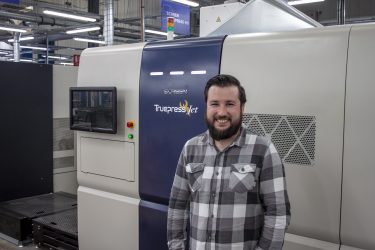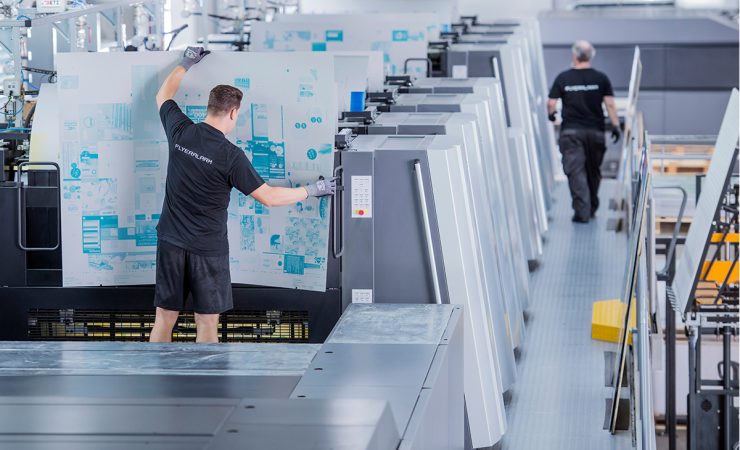It’s usually assumed that digital print is for short run and litho is for larger quantities, but the volume of work taken on by some trade printers means that the choice isn’t so simple. Andy Knaggs sees what lessons can be learned from their decision-making processes.
The larger trade and online printers have very much been at the forefront of efficient workflow and productivity, in many cases successfully developing automated systems that enable them to print thousands of jobs every day, with the minimum of manual intervention from their employees. In this way, they have been able to produce vast amounts of work quickly and at competitive prices.
One of the methods by which they, and other printers, have been able to do this over the years is by ganging work up, so that the maximum use is made of every sheet that goes through the press, whether digital or litho. There’s nothing new in this: two of the printers that Digital Printer has spoken to in researching this article have been operating in this way since they began – 1999 in the case of Solopress; 2002 with FlyerAlarm.
However, the process of ganging work in this way has now become one that, should a printer so choose, can be entirely automated, based on parameters defined by the company. And it can mean that relatively short run jobs that you might think were obvious candidates for digital print, can actually be produced more cost-effectively by adding them to the litho workflow. Personalised products can’t be done this way, of course, but the overwhelming majority of commercial print still doesn’t take advantage of this.
Southend-based Solopress is one printer that sees this approach as a necessity. Recently arrived managing director Simon Cooper said, ‘It allows us to be competitive in the market by minimising waste and ensuring we are maximising the yield from every set of plates and make ready. It’s an essential component for our business and table stakes for being involved in this [e-commerce printing] marketplace.’
Route 1 Print, part of Bluetree, started ganging jobs together in 2012, when it installed its first litho press at its Rotherham site – a B3 Heidelberg Anicolor. This was a massive step up in productivity from the firm’s Xerox iGens at that time.
Head of core systems Lewis Rogal says ganging work up increases Route 1’s capacity and improves its productivity, ensuring that it hits ‘optimum output levels’. Mr Rogal continued, ‘This process has played a key part in making Route 1 Print the UK’s largest and fastest growing trade printer. It allows us to deliver a 5-Star Trust Pilot rated service, quick turn-around times and keep our prices low, whilst delivering the quality our customers demand.’

Route 1’s Lewis Rogal says each job is evaluated on a number of criteria before deciding whether to print it litho or digital
Job attributes
What is the best approach to take to ganging jobs to maximise sheet utilisation though, and how does the application of automation here affect decisions about printing with digital or litho? Of course, there are certain obvious parameters that tip things one way or the other – paper stock type, for instance. Lewis Rogal explains that Route 1 has no strict policy about whether a product is sent to a digital or litho press.
‘The process is that we break every single job down into a series of attributes, including run length, total ink coverage, finishing requirements and product type. We then use these attributes to determine the most efficient way to produce the job. This is all automated; however, the system is set up to allow a production manager to intervene at any point.
‘It comes down to what is the most efficient production method of each job in isolation, rather than looking at a single factor. There are some exceptions to this: for example, our standard business card range is printed on our Fujifilm Jet Press 720s and our creative stock range are printed on our iGens,’ he adds.
Route 1 has a bespoke MIS that has been developed in-house by a team of six web developers, as well as having two full-time workflow specialists that Mr Rogal says ensure that jobs are managed through the process.
FlyerAlarm, the Germany-based online printing giant, also uses a great deal of automation in ganging its jobs up – it processes around 26,000 of them per day – and sending them to the most appropriate production line or site.
Divyesh Chotai, head of strategic partnerships at the company, told Digital Printer: ‘It was a lot of manual work at the start, but we’ve improved how we do this significantly over the years, and now everything is automated. Most of what we have done in automation is from our own in-house tools and development.’
Customers can specify whether they want a job printed digitally or litho, although below 25 copies it will always go into the digital print stream, and if they don’t express a preference, then the job will go into the litho stream. FlyerAlarm has a huge array of large format litho presses at its main Wurzburg factory, so it’s little wonder that Mr Chotai describes litho as ‘our bread and butter’.
‘It’s always a case of how we can produce the job,’ he explains. ‘We have a production plan in Germany, selecting which job goes to which production house. We’re always trying to find a way to reduce delivery times for customers, making it more efficient in ganging and getting colour consistency, which is a crucial part of ganging. The software does most of it, and finds accurate ways of ganging up jobs so that customers get the result they expect.’
Solopress, by contrast, seems to favour more of a human contribution when it comes to ganging jobs. ‘In our opinion it’s best to use humans to manage this process,’ said Simon Cooper. ‘Certain product types are fully automated but for the rest, our grid operators look at which job they have on each material and match the quantities until a full grid is complete. Once the grid is gathered by the grid operator, we then use an automated imposition software to impose each individual job on a ganged sheet.’
The company sees the run length split between digital and litho being at around the 250 mark, and manages this through its own proprietary production management system. ‘When an order is placed on our website, our systems are automating the proofing and prepress flow,’ said Mr Cooper.

Simon Cooper, now at Solopress, is focused on minimising waste and maximising yield but says that human decision making matters
Quality and choice
In spite of the efficiencies it can bring in terms of productivity and materials utilisation, however, there is a different way of looking at the issue of ganging jobs together – one that champions customer choice and production control instead.
Steve Wenlock, managing director of trade printer Flexpress in Leicester, is happy to fly that flag, saying: ‘Fundamentally, it’s about quality and choice. We don’t want to coerce people into a narrow range of materials just to fill a sheet with similar jobs, we want them to be able to choose whatever stock they want and order whatever quantity they want too; not have to round up, or down.
‘Equally, running one job at a time means we maintain a little more control over colour, quality and timing. We don’t have to compromise anything for the sake of other jobs on the sheet and it gives a little more flexibility over deadlines.
‘Yes, clients do pay a little more, but generally only to the point jobs become impractical to batch anyway.’
Ultimately, the decision whether or not to gang work to make best use of the sheet might be seen as a trade off between fast turnaround efficiency, and a more stately, considered approach that values a deeper customer focus. Overall volumes and the nature of the client base both figure heavily in such a decision – either way, it is about making the production process work for your business and its customers.





